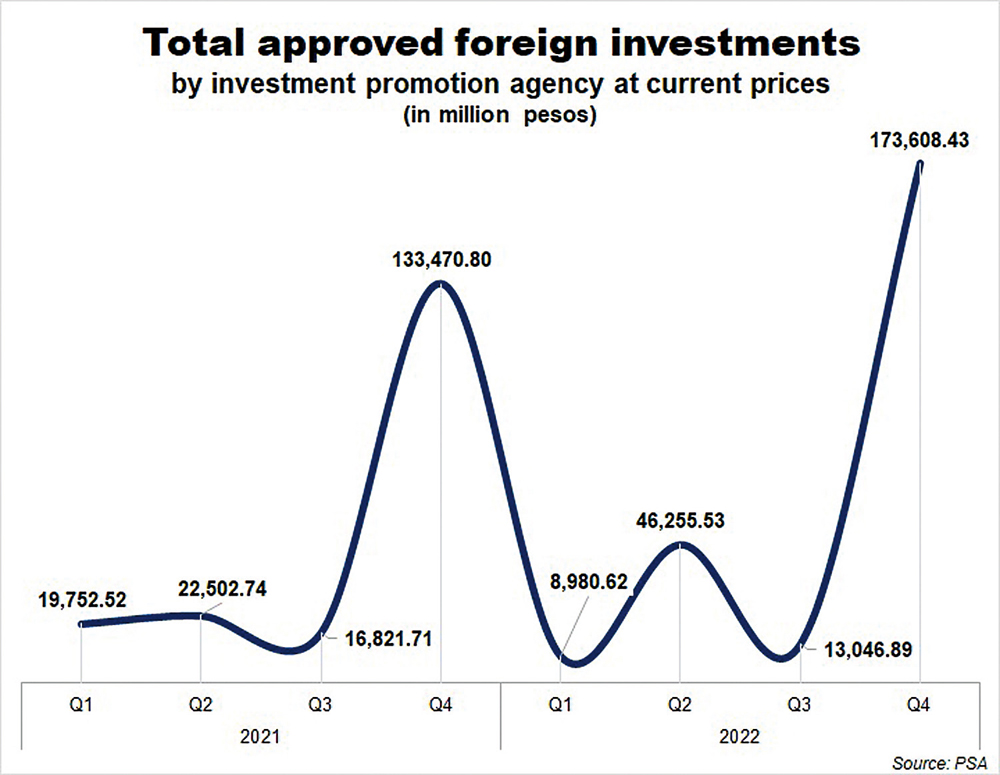Rates at 15-yr high; more hikes seen
With inflation now possible to average 6 percent this year–a couple of percentage points higher than the government’s top-end of the target–the policymaking Monetary Board yesterday jacked up the key rates of the Bangko Sentral ng Pilipinas anew to hit its highest in 15 years.
The interest rate on the BSP’s overnight reverse repurchase facility was raised by another 50 basis points to 6.0 percent, effective today. Accordingly, the interest rates on the overnight deposit and lending facilities was set to 5.5 percent and 6.5 percent, respectively.
Felipe Medalla, BSP Governor and Monetary Board chief, said in deciding to raise the policy interest rate anew, the Board noted the latest baseline inflation forecast path has shifted higher relative to the previous assessment.
This was the eighth consecutive tightening action by the Monetary Board. Prior to yesterday’s tweak, the key rates have been raised by a total of 350 bps.
Medalla said while inflation expectations remain elevated for the next few months, more rate hikes are possible.
“(There will be) More rate hikes moving forward. We cannot rule out anything. It’s unlikely that we will not raise rates. Two 25 bps hike(s). Personally, I think we don’t have to resort to 75bps. If I were to make a choice, I will rule out 0 and 75 bps,” Medalla said.
“The policy rate is still not as restrictive. A 50 bps hike will just cut 0.04 percent of GDP,” he added.
Medalla said average inflation is projected to breach the upper end of the 2 to 4 percent target range at 6.1 percent in 2023, before returning to within target at 3.1 percent in 2024.
“The forecasts were adjusted upwards following the higher-than-expected inflation outturn in January as well as the continued stronger rebound in domestic demand and gross domestic product (GDP) growth in the fourth quarter of last year,” he said.
Higher food prices and utility rates pushed inflation faster in January, hitting its highest since November of 2008 and breaching the top end of the central bank’s forecast for the month.
The Philippine Statistics Authority said inflation accelerated further to 8.7 percent in January from 8.1 percent in December 2022 and 3 percent a year ago.
Core inflation, which excludes selected food and energy items in the headline inflation, rose to 7.4 percent from 6.9 percent the previous month and 1.8 percent the previous year.
“Both headline and core inflation measures have also continued to increase, indicating a further broadening of price pressures, particularly in services. Meanwhile, inflation expectations have likewise risen further, underscoring the need to preempt the emergence of further second-round effects,” Medalla said.
Medalla noted the balance of risks to inflation now leans toward the upside for both 2023 and 2024, “with pressures emanating from the potential impact of global food market uncertainties, continued domestic shortages in key food items, additional transport fare hikes amid elevated oil prices, and the higher-than-expected wage adjustments in 2023.”
The impact of a weaker-than-expected global economic recovery remains the primary downside risk to the inflation outlook.
Medalla said the Monetary Board also reiterates its encouragement and support for timely and more aggressive whole-of-government actions to mitigate the impact of persistent supply-side pressures on food prices, including trade”‘positive measures and significant progress to boost productivity.
“Given these considerations, the Monetary Board deems a strong follow-through monetary policy response as necessary to reduce the risk of a breach in the inflation target in 2024,” Medalla said.
He explained an upward adjustment in the policy interest rate would also prevent inflation expectations from drifting further away from the target band.
The Monetary Board also believes that, with domestic growth exceeding expectations in 2022, monetary action can help to dampen potential demand-side pressures and second-round effects without unduly hindering the sustained momentum of economic growth.
“The BSP reassures the public that it stands ready to take all necessary policy action to bring inflation to within the 2 to 4 percent government target over the medium term, in line with its primary mandate of ensuring price stability,” Medalla said.
Michael Ricafort, RCBC chief economist, said local policy rates would still be largely a function of the local inflation trend as well as future rate hikes by the US policymaking body, the Federal Reserve.
“For the coming months, local policy rates could still, at the very least, match any future Fed rate hikes after recent Fed signals and market expectations of about 2 to 3 more Fed rate hikes on the next Fed rate-setting meetings. As a result, any additional Fed rate hikes of about +0.25 each could be, at least, matched locally on the next local rate-setting meetings on March 23, 2023 and on May 18, 2022 to maintain a more comfortable interest rate differential that help stabilize the peso exchange rate and overall inflation,” Ricafort said.
He said relatively elevated inflation in recent months would also be a consideration on the size of any further local policy rate hike.





